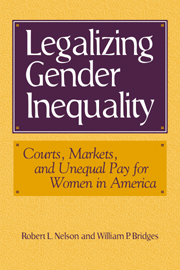Book contents
- Frontmatter
- Contents
- List of Figures and Tables
- Acknowledgments
- 1 Law, Markets, and the Institutional Construction of Gender Inequality in Pay
- Part I Theory and Method
- Part II The Case Studies
- Part III Conclusion: Legalizing Gender Inequality
- Appendix: Court Documents and Case Materials Used in Case Studies
- References
- Index
1 - Law, Markets, and the Institutional Construction of Gender Inequality in Pay
Published online by Cambridge University Press: 07 August 2009
- Frontmatter
- Contents
- List of Figures and Tables
- Acknowledgments
- 1 Law, Markets, and the Institutional Construction of Gender Inequality in Pay
- Part I Theory and Method
- Part II The Case Studies
- Part III Conclusion: Legalizing Gender Inequality
- Appendix: Court Documents and Case Materials Used in Case Studies
- References
- Index
Summary
The pay equity movement won its largest legal victory in 1983, when Judge Jack Tanner of the federal District Court of Western Washington found that the State of Washington had discriminated against workers in predominantly female jobs and awarded the plaintiffs a $400 million judgment. The AFSCME decision (so named because the American Federation of State, County, and Municipal Employees brought the lawsuit) catapulted the pay equity issue into instant prominence. In its immediate aftermath, the number of states conducting pay equity studies doubled to thirty-four, and the number of articles on pay equity in leading newspapers quadrupled (McCann 1994, 54–59). The victory was shortlived, however. In 1985, the Ninth Circuit Court of Appeals reversed the AFSCME decision. Then judge, now justice, Anthony Kennedy pronounced, “Neither law nor logic deems the free market a suspect enterprise…. Title VII does not obligate [the State of Washington] to eliminate an economic inequality it did not create” (AFSCME, 1407). According to Justice Kennedy, the plaintiffs not only lacked a legal basis for redress, but the very nature of their thinking – their logic – was wrong. The Ninth Circuit authoritatively denounced plaintiffs' theory of gender-based wage inequality as inconsistent with a core institution of American society – the free market.
The reversal of the AFSCME decision had a devastating effect on the pay equity movement. Other courts followed the AFSCME precedent in rejecting similar claims. Reform activity in states and municipalities slowed to a trickle.
- Type
- Chapter
- Information
- Legalizing Gender InequalityCourts, Markets and Unequal Pay for Women in America, pp. 1 - 22Publisher: Cambridge University PressPrint publication year: 1999



